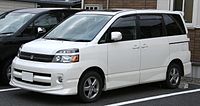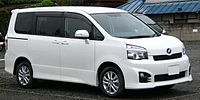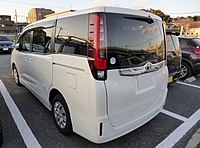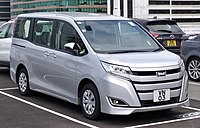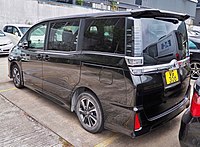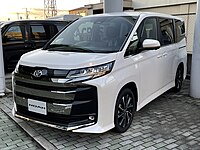The Toyota Noah (Japanese: トヨタ・ノア, Hepburn: Toyota Noa) is a minivan with two rear sliding doors built by Toyota and sold mainly in Asian countries. It is positioned below the Alphard, and above the Sienta. The Noah was also positioned below the Estima until the latter was discontinued in 2019.
| Toyota Noah | |
|---|---|
 2022 Toyota Noah Hybrid S-G | |
| Overview | |
| Manufacturer | Toyota |
| Also called |
|
| Production | November 2001[3] – present |
| Body and chassis | |
| Class | Minivan |
| Body style | 5-door minivan |
| Layout | |
| Chronology | |
| Predecessor | Toyota TownAce/LiteAce Noah (R40/R50) |
Being a front-wheel drive-based vehicle, it replaces the rear-wheel drive-based TownAce/LiteAce Noah, while retaining the "R" model code series and generation numbering. In contrast with its predecessor, the Noah features rear sliding doors on both sides.[4]
The twin version of the Noah is named the Toyota Voxy (Japanese: トヨタ・ヴォクシー, Hepburn: Toyota Vokushī). It is marketed as the sportier version of the Noah, featuring split-type headlights and clear taillight lens, a styling trait that would later be shared with the larger Vellfire. For the third generation, another twin version was also available, named the Toyota Esquire (Japanese: トヨタ・エスクァイア, Hepburn: Toyota Esukwaia). It was marketed as the more luxurious version of the Noah, sported a different grille design and more upmarket interior. Starting with the fourth generation, the Noah is also rebadged and sold by Suzuki as the fourth-generation Suzuki Landy (Japanese: スズキ・ランディ, Hepburn: Suzuki Randi), which replaced the previous Nissan Serena-based model.[2]
Up until the third generation, the vehicle was specifically developed to provide variants that complies with the Japanese dimension regulations for compact vehicles with length dimensions under 4,700 mm (185.0 in) and width under 1,700 mm (66.9 in) ("class five" vehicle), which placed it in the lower end of the annual road tax bracket which contributed to its high demand.[5][6] Since the fourth generation, all variants have exceeded the 1,700 mm (66.9 in) width limit, which made it classified as a "class three" vehicle.
For the first three generations, the Noah is based on the same platform as the Ipsum, with improvements and upgrades throughout its successive generations while retaining most of the rear floor panel.[7] Since the fourth-generation model, the Noah adopted the TNGA platform.[8]
The Noah was once exclusive to Toyota Corolla Store Japanese dealerships, the Voxy to Netz Store, and the Esquire to Toyopet Store. On 1 May 2020, the Noah, Voxy, and Esquire became available at all Toyota dealership sales channels in Japan (Toyota Store, Toyopet Store, Corolla Store and Netz). The Esquire was later discontinued in December 2021.[1]
First generation (R60; 2001)
| First generation | |
|---|---|
 2001–2004 Noah X (pre-facelift) | |
| Overview | |
| Model code | R60 |
| Also called | Toyota Voxy |
| Production | November 2001[3] – June 2007 |
| Assembly | Japan: Kariya, Aichi (Toyota Auto Body)[3] |
| Body and chassis | |
| Platform | Toyota MC platform |
| Related | Toyota Ipsum (XM20) |
| Powertrain | |
| Engine |
|
| Power output | 114 kW (153 hp; 155 PS) |
| Transmission | |
| Dimensions | |
| Wheelbase | 2,825 mm (111.2 in) |
| Length | 4,580–4,625 mm (180.3–182.1 in) |
| Width | 1,695 mm (66.7 in) |
| Height | 1,850 mm (72.8 in) |
| Kerb weight | 1,500 kg (3,307 lb) |
The first-generation Noah and Voxy were released in November 2001. Newly developed based on the Ipsum platform, it is the first time the Noah nameplate adopted a front-wheel drive layout.[9] The model is equipped with the H∞ TEMS suspension.[10]
The facelift model was released in August 2004 and was discontinued in June 2007.
Gallery
- Noah
- 2001–2004 Noah X (pre-facelift)
- 2001–2004 Noah S (pre-facelift)
- 2004–2007 Noah X (facelift)
- 2004–2007 Noah X (facelift)
- Voxy
- 2001–2004 Toyota Voxy X (pre-facelift)
- 2004–2007 Voxy X (facelift)
- 2004–2007 Voxy Z (facelift)
- 2005 Voxy
Second generation (R70; 2007)
| Second generation | |
|---|---|
 2007–2010 Noah X (pre-facelift) | |
| Overview | |
| Model code | R70 |
| Also called |
|
| Production |
|
| Assembly |
|
| Body and chassis | |
| Platform | Toyota MC platform |
| Powertrain | |
| Engine |
|
| Power output |
|
| Transmission | CVT |
| Dimensions | |
| Wheelbase | 2,825 mm (111.2 in) |
| Length | 4,595–4,630 mm (180.9–182.3 in) |
| Width | 1,695–1,720 mm (66.7–67.7 in) |
| Height | 1,850–1,875 mm (72.8–73.8 in) |
| Kerb weight | 1,550–1,700 kg (3,417–3,748 lb) |
The second-generation Noah and Voxy were released in June 2007. The facelifted model was released in April 2010 and was discontinued in January 2014.
For 2007 models on Japanese models only, G-BOOK, a subscription telematics service was available as an option.
Indonesia
In Indonesia, the facelifted second-generation Noah was launched on 11 December 2012 as the Toyota NAV1, which filled the gap between the Kijang Innova and the Alphard. It was CKD-assembled at Sugity Creatives, a subsidiary of Toyota Auto Body in Bekasi, West Java, and available in two grade levels, G and V. The engine used is the 2.0-litre 3ZR-FAE four-cylinder petrol unit mated with a continuously variable transmission.[12][13] In 2014, the V Limited grade was added.[14]
After the NAV1 was discontinued in January 2017 due to declining sales, it was replaced by the facelifted third-generation Voxy in August of the same year, which is imported from Japan.[15] A total of 4,483 NAV1s were sold.[16]
Gallery
- Noah
- 2007–2010 Noah S (pre-facelift)
- 2007–2010 Noah Si (pre-facelift)
- 2007–2010 Noah Si (pre-facelift)
- 2010–2014 Noah X (facelift)
- 2012 Noah Luxury (Hong Kong; facelift)
- 2010–2014 Noah Si G's (facelift)
- 2010–2014 Noah Si G's (facelift)
- 2007 Noah X interior
- Voxy
- 2007–2010 Voxy X (pre-facelift)
- 2007–2010 Voxy V (pre-facelift)
- 2007–2010 Voxy ZS (pre-facelift)
- 2010–2014 Voxy ZS (facelift)
- 2010–2014 Voxy G's (facelift)
- 2010–2014 Voxy G's (facelift)
- NAV1 (Indonesia)
- 2013 Toyota NAV1 V (Indonesia)
- 2013 NAV1 V (Indonesia)
Third generation (R80; 2014)
| Third generation | |
|---|---|
 2014–2017 Noah G (pre-facelift) | |
| Overview | |
| Model code | R80 |
| Also called |
|
| Production | January 2014 – December 2021 |
| Assembly | Japan: Kariya, Aichi (Toyota Auto Body Fujimatsu Plant);[3] Toyota, Aichi (Motomachi plant)[17] |
| Designer |
|
| Body and chassis | |
| Platform | Toyota New MC platform |
| Powertrain | |
| Engine | |
| Electric motor | 5JM AC synchronous (hybrid) |
| Power output |
|
| Transmission | |
| Hybrid drivetrain | Power-split (hybrid) |
| Battery | 6.5 Ah nickel–metal hydride (hybrid) |
| Dimensions | |
| Wheelbase | 2,850 mm (112.2 in) |
| Length | 4,695–4,710 mm (184.8–185.4 in) |
| Width | 1,695–1,735 mm (66.7–68.3 in) |
| Height | 1,825–1,870 mm (71.9–73.6 in) |
| Kerb weight | 1,560–1,730 kg (3,439–3,814 lb) |
The third-generation Noah and Voxy were introduced in January 2014. For the first time, an engine start-stop system was used to improve fuel economy. It was also the first Toyota minivan to have one-touch sliding doors. In October 2014, the Esquire was launched, which was marketed as a more luxurious version of the Noah. The monthly sales target was set at 3,400 units for Noah, which was sold at Toyota Corolla Store dealership chain and 4,600 units for Voxy sold at Netz Store dealerships.[22]
The lower grade levels of the third-generation Noah (without the "aero body" package, which came standard for the Voxy and Esquire) maximized its exterior dimensions within Japanese dimension regulations by increasing its length by 100 mm (3.9 in) to 4,695 mm (184.8 in). By adopting a newly developed low-floor platform, the overall height of the third-generation model is reduced by 25 mm (1.0 in) compared to the previous model, while the interior height is increased by 60 mm (2.4 in) to 1,400 mm (55.1 in).[22]
The Noah/Voxy/Esquire also received Toyota's T-Connect services as well as Toyota Safety Sense C which incorporated features such as collision warning, lane assist, as well as high beam assist.
The Noah/Voxy/Esquire received a facelift on 3 July 2017 with changes to the lights, bonnet (hood), bumper and the front fender, and was discontinued in late 2021.
Indonesia
The facelifted third-generation Voxy was launched in Indonesia on 10 August 2017. Unlike the preceding NAV1, which was assembled locally, the Voxy was imported from Japan. Export to Indonesia began in July 2017. It was only offered in one grade equivalent to the Japanese ZS grade.[23][24]
Gallery
- Noah
- 2014–2017 Noah G (pre-facelift)
- 2014–2017 Noah Si (pre-facelift)
- 2014–2017 Noah Si (pre-facelift)
- 2017–2021 Noah X (facelift)
- 2017–2021 Noah Hybrid X (facelift)
- 2017–2021 Noah Si (facelift)
- 2017–2021 Noah Si (facelift)
- Noah Si GR Sport
- Noah Si GR Sport
- 2019 Noah G (facelift) TRD version
- Voxy
- 2014–2017 Voxy X C Package (pre-facelift)
- 2014–2017 Voxy ZS (pre-facelift)
- 2014–2017 Voxy ZS (pre-facelift)
- 2017–2021 Voxy Hybrid V (facelift)
- 2017–2021 Voxy ZS Kirameki (facelift)
- 2017–2021 Voxy ZS Kirameki (facelift)
- Voxy ZS GR Sport
- Voxy ZS GR Sport
- 2018 Voxy (Indonesia)
- Voxy ZS interior (pre-facelift)
- Esquire
- 2014–2017 Toyota Esquire (pre-facelift)
- 2014–2017 Esquire Hybrid (pre-facelift)
- 2017–2021 Esquire Hybrid (facelift) used as a taxi
- 2017–2021 Esquire Gi (facelift)
Fourth generation (R90; 2022)
| Fourth generation | |
|---|---|
 2022 Noah X (MZRA90W) | |
| Overview | |
| Model code | R90 |
| Also called |
|
| Production | January 2022 – present |
| Assembly |
|
| Designer | |
| Body and chassis | |
| Platform | TNGA: GA-C[26] |
| Related | Toyota Innova (AG10) |
| Powertrain | |
| Engine | |
| Electric motor |
|
| Power output |
|
| Transmission | |
| Hybrid drivetrain | Power-split (hybrid) |
| Battery | 4.08 Ah lithium-ion (hybrid) |
| Dimensions | |
| Wheelbase | 2,850 mm (112.2 in) |
| Length | 4,695 mm (184.8 in) |
| Width | 1,730 mm (68.1 in) |
| Height | 1,895–1,925 mm (74.6–75.8 in) |
| Kerb weight | 1,600–1,710 kg (3,527–3,770 lb) |
The fourth-generation Noah and Voxy were introduced on 13 January 2022, which are built on the GA-C platform that is revised and adapted for minivans.[7][26] The Esquire nameplate was not continued in this generation.
The length and wheelbase of the fourth-generation model is unchanged from its predecessor, although the width dimension for all models is 1,730 mm (68.1 in), which is 35 mm (1.4 in) wider than the lower variant third-generation Noah. As the result, Noah/Voxy model exceeded the 1,700 mm (66.9 in) threshold of the "compact car" class under Japanese dimension regulations.[28]
The Noah is offered in X, G, Z, S-G, and S-Z grade levels, while the Voxy is only available in S-G and S-Z grades.[29] For the first time, the Noah no longer wears the stylized 'N' insignia on the front end, with Toyota's corporate triple oval emblem replacing it.
The Noah is also marketed by Suzuki in Japan as the fourth-generation Suzuki Landy since 8 August 2022 through an OEM agreement, replacing the previous Nissan Serena-based model.[2]
Indonesia
The fourth-generation Voxy was launched in Indonesia on 17 February 2022.[30] Like the previous model, it is only offered in one grade with Toyota Safety Sense as standard equipment.[31]
Gallery
- Noah
- 2022 Noah X (MZRA90W)
- 2022 Noah S-Z (MZRA90W)
- 2022 Noah Hybrid S-Z (ZWR90W)
- Voxy
- 2022 Voxy (MZRA90)
- 2022 Voxy S-Z (MZRA90W)
- Voxy Hybrid S-G interior
- Suzuki Landy
- 2022 Suzuki Landy G (MZRA90C)
- 2022 Suzuki Landy Hybrid G (ZWR90C)
Sales
| Year | Japan | Indonesia[32] | Malaysia[33][lower-roman 1] | |||||
|---|---|---|---|---|---|---|---|---|
| Noah[34] | Voxy[35] | Esquire[36] | NAV1 | Voxy | Noah | Voxy | Esquire | |
| 2002 | 97,080 | 77,958 | 2 | |||||
| 2003 | 86,922 | 56,343 | ||||||
| 2004 | 77,146 | 62,371 | 2 | |||||
| 2005 | 72,859 | 72,991 | ||||||
| 2006 | 54,283 | 63,546 | ||||||
| 2007 | 61,064 | 73,457 | 1 | 2 | ||||
| 2008 | 57,477 | 70,165 | 1 | |||||
| 2009 | 52,933 | 71,426 | ||||||
| 2010 | 56,955 | 72,163 | 1 | |||||
| 2011[37] | 38,855 | 48,652 | 1 | 2 | ||||
| 2012[38] | 36,764 | 50,539 | 40[39] | 1 | ||||
| 2013[40] | 32,306 | 41,918 | 2,830[39] | 3 | 1 | |||
| 2014[41] | 69,605 | 109,174 | 11,028 | 535[39] | 2 | 4 | ||
| 2015[42] | 53,965 | 92,546 | 59,034 | 577[43] | 10 | |||
| 2016[44] | 54,826 | 91,868 | 44,881 | 501 | 7 | |||
| 2017[45] | 58,729 | 86,772 | 43,210 | 977[46][47] | 4 | |||
| 2018[48] | 56,719 | 90,759 | 40,224 | 5,272[49] | 1 | 26 | ||
| 2019[50][51] | 52,684 | 88,012 | 40,553 | 3,634[47] | 8 | 108 | ||
| 2020[52] | 45,434 | 69,517 | 26,368 | 1,807[53][47] | 32 | 440 | 42 | |
| 2021[54] | 44,211 | 70,085 | 12,482 | 1,428[47] | 83 | 686 | 22 | |
| 2022 | 57,696 | 55,545 | 2,505 | 200 | 1,171 | 23 | ||
| 2023 | 95,181 | 89,080 | 2,749 | 291 | 1,564 | 27 | ||
- Figures based on registration, includes grey imports and used car imports (Malaysia)
References
External links
Wikiwand in your browser!
Seamless Wikipedia browsing. On steroids.
Every time you click a link to Wikipedia, Wiktionary or Wikiquote in your browser's search results, it will show the modern Wikiwand interface.
Wikiwand extension is a five stars, simple, with minimum permission required to keep your browsing private, safe and transparent.






